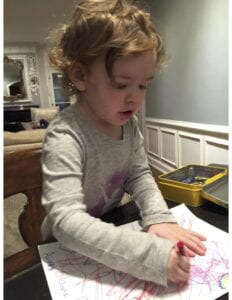
Surely the benefit in learning is not simply increasing one’s pool of knowledge. Knowledge increases in value when we can make fluid interconnections and practically apply what we have learned. Even more, knowledge becomes invaluable when it is effectively shared. This is true of art as well. Certainly, there is an intrinsic value for the artist to understand the properties of various materials (ink, pencil, charcoal), and understand how to employ various techniques (shading or perspective). There is also, arguably, greater value in using this knowledge to create an image that effectively conveys a curated message.
To this end, my second goal has two aims: 1.) to develop artifacts that highlight the interconnections between handwriting dysfunction and handwriting interventions, and 2.) produce artifacts that effectively share an impactful message.
______________________________________________________________________________
Goal 2: Produce evidence-based educational resources for occupational therapy practitioners treating children with identified handwriting dysfunction. (AOTA 2021 Standards for Continuing Competence in Occupational Therapy: Knowledge, Professional Reasoning, Ethical Practice, Interpersonal).
Since I began the doctoral program at NYU, I have studied diligently to increase my own pool of knowledge on handwriting. The intention of which has always been to process the knowledge and transform it into usable practice. To this end, my next two artifacts highlight important interconnections between handwriting dysfunction and handwriting interventions. While there are many useful and usable interconnections underlined in these artifacts, there are also important curated messages. They are not necessarily unique messages (like art, many of the best themes are used and reused), but they are important messages that benefit from being underscored and shared.
______________________________________________________________________________
Artifact 1: Ohio State Conference Presentation
Handwriting, Keyboarding or Both: Using the Right Tool for the Right Task
Within the literature on handwriting, there is often a question asked about the continued significance of handwriting in the 21st century. It is a legitimate question. Technology is perpetually improving and there are now various practical and economical options that reduce the demand for handwriting. When I was enrolled in the course, Assistive Technology: Learning and Participation in Schools (taught by Mark Surabian), I came upon a new appreciation of this question. Although (as enumerated throughout the artifacts in this ePortfiolio) there are essential benefits in learning to write by hand; can and should keyboarding replace handwriting for children struggling to acquire proficiency? In the following artifact, I examine this pointed question and provide a curated message: Context matters. Both handwriting and keyboarding proficiency are important and beneficial skills to acquire independent of each other. Occupational therapy practitioners should encourage both and help students identify individually when and how each skill should be implemented based on context.
______________________________________________________________________________
Handwriting Intervention Primer
Certainly, it is important to recognize the indelible value in learning to write letters. But when children struggle to acquire this skill, how can occupational therapy practitioners intervene? Throughout my time developing this ePortfolio, my content mentor, Karen Roston, DPS, OTR/L, often asked me to think about handwriting dysfunction and occupational therapy interventions. She noted that, as occupational therapists, we most often become involved with handwriting interventions for children with identified handwriting difficulties. Keeping this in mind, I set out to explore and understand the interconnection between why specific handwriting difficulties may occur and what interventions will be most appropriate. The Handwriting Intervention Primer was developed to communicate this knowledge to occupational therapy practitioners and provide practical evidence-based strategies to improve handwriting acquisition.
The message of my second artifact melds with the message of the first artifact. For students struggling with handwriting acquisition, the objective of the interventions should not be overly focused on legibility and speed. These measures can be improved with practice, and moreover, can be enhanced by using a keyboard as students advance through school. Instead, interventions should focus on gaining automaticity, or the ability to produce allographs without conscious attention to the mechanics.
______________________________________________________________________________